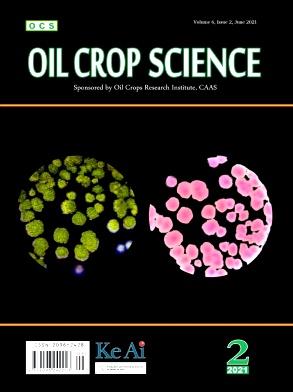The impact of drought stress on morpho-physiological characteristics of rapeseed cultivars (Brassica napus L.)
Q3 Agricultural and Biological Sciences
引用次数: 0
Abstract
The morpho-physiological responses of 15 rapeseed genotypes to drought stress were assessed, revealing strong correlations among various characteristics. Under control conditions, the genotype Angelico fascinated the highest chlorophyll content, while Nilofar had the highest carotenoid content, grain yield, and harvest index (HI). Talaye recorded the highest proline content. Under drought conditions, Nafis maintained the highest plant height, pod number, biomass, and grain yield. Angelico demonstrated the highest chlorophyll and relative water content (RWC). Nima showed the highest carotenoid content, Zarfam excelled in chlorophyll b, and Nafis recorded the highest proline content. Overall, drought stress resulted in a significant reduction in most morpho-physiological traits. In the principal component analysis (PCA), the first two components explained a substantial portion of the variation in both control and drought conditions, facilitating the classification of the genotypes into two distinct groups. Additionally, twelve drought stress indices further categorized the genotypes, with the first two components accounting for the majority of the variation (99.45%). Notably, the Nilofar, Nima, Nafis, and Shirali cultivars were grouped together under both control and drought conditions, exhibiting the highest grain yield. These genotypes could be considered drought-tolerant varieties of this study. The research identified stable and high-performing rapeseed genotypes, which are recommended for future breeding programs.
干旱胁迫对甘蓝型油菜形态生理特性的影响
分析了15个油菜基因型对干旱胁迫的形态生理响应,发现各性状之间存在较强的相关性。在对照条件下,Angelico基因型的叶绿素含量最高,Nilofar基因型的类胡萝卜素含量、籽粒产量和收获指数(HI)最高。塔拉叶脯氨酸含量最高。在干旱条件下,Nafis保持最高的株高、豆荚数、生物量和粮食产量。当归的叶绿素和相对含水量(RWC)最高。Nima的类胡萝卜素含量最高,Zarfam的叶绿素b含量最高,Nafis的脯氨酸含量最高。总体而言,干旱胁迫导致大多数形态生理性状显著降低。在主成分分析(PCA)中,前两个成分解释了对照和干旱条件下的大部分变异,有助于将基因型分为两个不同的群体。此外,12个干旱胁迫指标进一步对基因型进行了分类,其中前两个成分占变异的大部分(99.45%)。值得注意的是,在对照和干旱条件下,Nilofar、Nima、Nafis和Shirali品种组合在一起,表现出最高的粮食产量。这些基因型可以被认为是本研究的耐旱品种。该研究确定了稳定和高性能的油菜籽基因型,为未来的育种计划提供了建议。
本文章由计算机程序翻译,如有差异,请以英文原文为准。
求助全文
约1分钟内获得全文
求助全文
来源期刊

Oil Crop Science
Food Science, Plant Science, Agronomy and Crop Science
CiteScore
3.40
自引率
0.00%
发文量
20
审稿时长
74 days
 求助内容:
求助内容: 应助结果提醒方式:
应助结果提醒方式:


